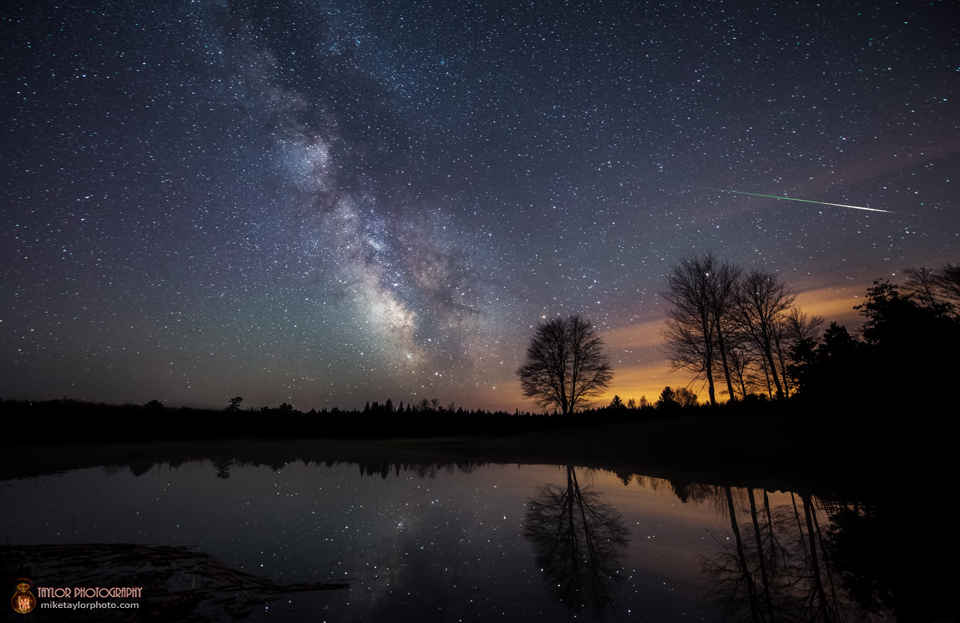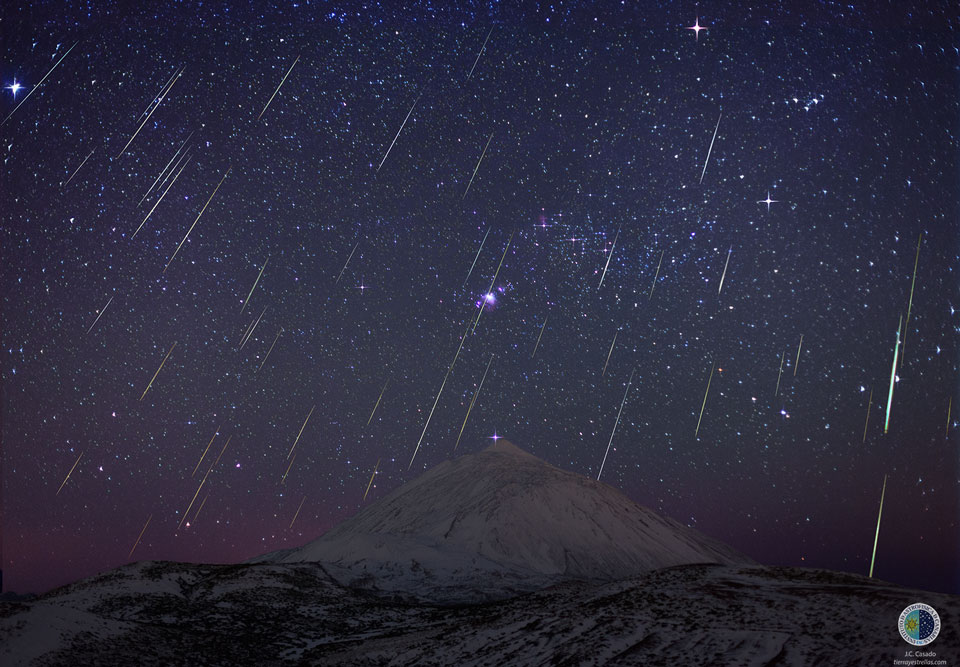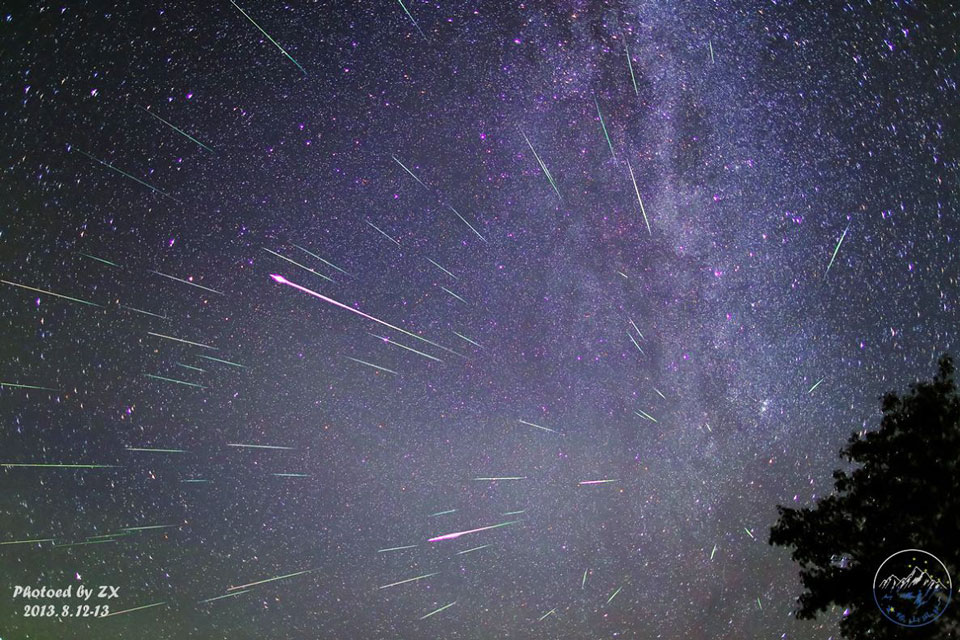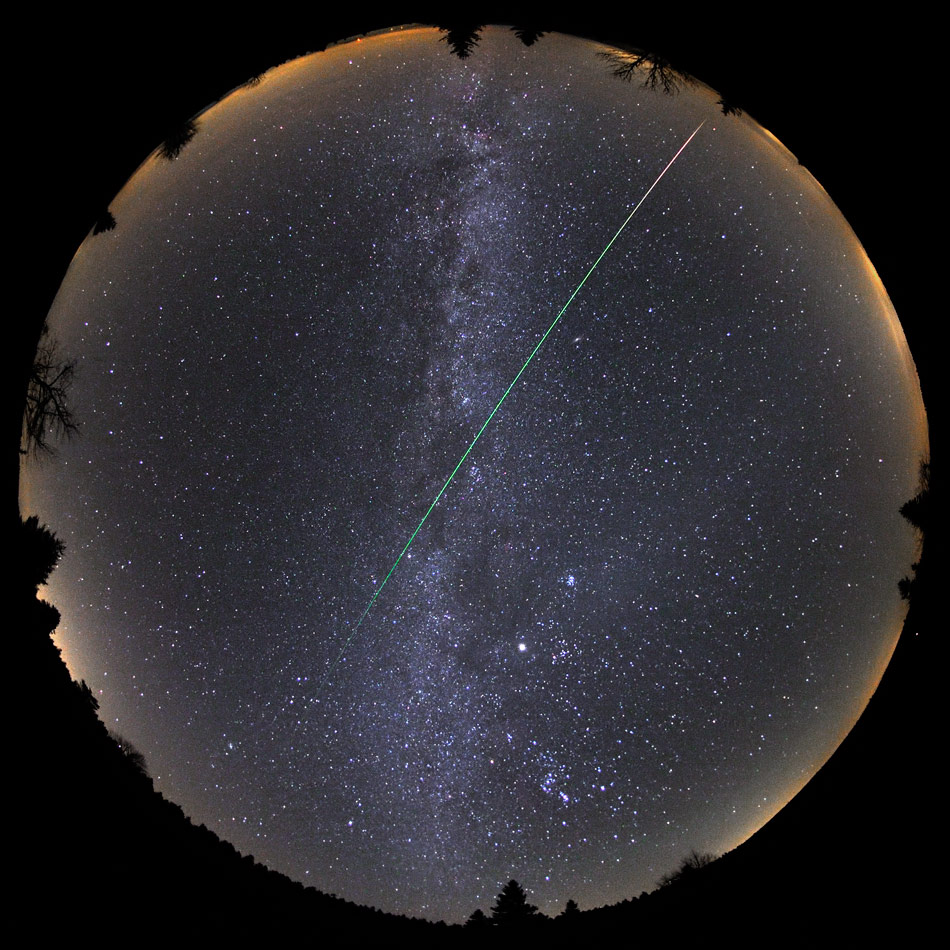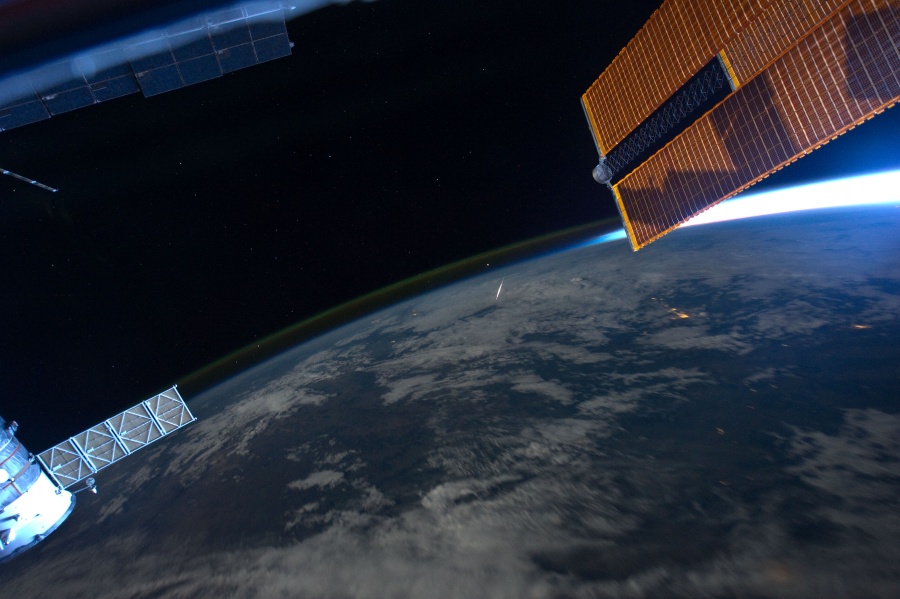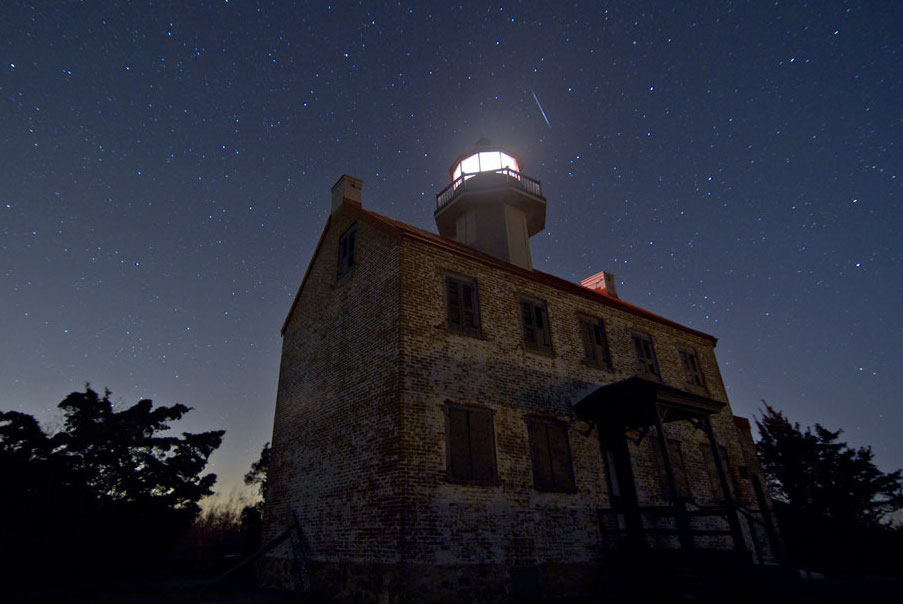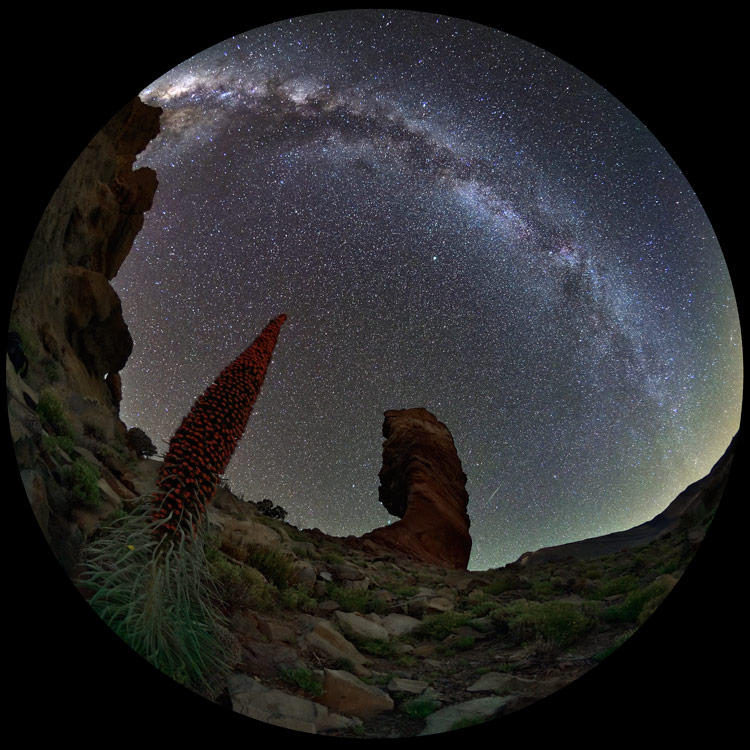Submission Gallery: Camelopardalids, May 2014
Submission Gallery: Camelopardalids, May 2014
Please post your Camelopardalids images here. (I'm assuming these are not a bust!!)
Please see this thread before posting images; posting images demonstrates your agreement with the possible uses for your image.
Those viewing the thread: this thread will be updated throughout the next few days. Check back to see the latest images!
Thank you!
Please see this thread before posting images; posting images demonstrates your agreement with the possible uses for your image.
Those viewing the thread: this thread will be updated throughout the next few days. Check back to see the latest images!
Thank you!
A closed mouth gathers no foot.
-
rjmauels
Re: Submission Gallery: Camelopardalids, May 2014
At The Colony, TX, USA - Saw one (1) at 12:33 AM CDT. It was real nice, moving at a medium speed from NNW to SSE for about 25 degrees directly overhead, with the expected radiant. It wasn't a quick, thin bright line and gone... It definitely had some granularity and width to it, and the ionized trail lasted for a couple of seconds. Color seemed a bit more toward orange than blue, green or violet.
That was with about a 50% clouded sky. After that, the breaks in the clouds got more irregular and a smaller and smaller percentage of the sky was viewable. Went indoors around 1:25 AM CDT, with the whole sky clouded, although about 10% of those clouds were still thin enough to see through. Back outside for 6 minutes at 2:20 AM CDT, but saw nothing in the best part of the sky - about 20% with a thin cloud cover (est. 50% translucent).
That was with about a 50% clouded sky. After that, the breaks in the clouds got more irregular and a smaller and smaller percentage of the sky was viewable. Went indoors around 1:25 AM CDT, with the whole sky clouded, although about 10% of those clouds were still thin enough to see through. Back outside for 6 minutes at 2:20 AM CDT, but saw nothing in the best part of the sky - about 20% with a thin cloud cover (est. 50% translucent).
-
BDanielMayfield
- Don't bring me down
- Posts: 2524
- Joined: Thu Aug 02, 2012 11:24 am
- AKA: Bruce
- Location: East Idaho
Re: Submission Gallery: Camelopardalids, May 2014
I was clouded out, but from the lack of reports and submissions it seems like it may have been a bust.
Just as zero is not equal to infinity, everything coming from nothing is illogical.
Re: Submission Gallery: Camelopardalids, May 2014
It was clear (and surprisingly chilly!) here; I was outside looking both before peak and during peak hours. A couple or three meteors and for that, I'm including the one I was between my outside stints on the live NASA feed. Woke my kid up for peak hours, too, poor thing!
~~ sigh ~~
~~ sigh ~~
A closed mouth gathers no foot.
-
BDanielMayfield
- Don't bring me down
- Posts: 2524
- Joined: Thu Aug 02, 2012 11:24 am
- AKA: Bruce
- Location: East Idaho
Re: Submission Gallery: Camelopardalids, May 2014
Yes (to the sigh). It really would be nice to see one of these hyped up forecasts live up to expectations, wouldn't it.owlice wrote:It was clear (and surprisingly chilly!) here; I was outside looking both before peak and during peak hours. A couple or three meteors and for that, I'm including the one I was between my outside stints on the live NASA feed. Woke my kid up for peak hours, too, poor thing!
~~ sigh ~~
I think that comet and meteor forecasting today resembles weather forecasting of the day's of our youth.
By the way, how dark is your sky owlice? You may have been very lucky to have seen any at all.
Just as zero is not equal to infinity, everything coming from nothing is illogical.
Re: Submission Gallery: Camelopardalids, May 2014
Meteor Showers
Since the Camelopardalids were quiet and people are hoping for meteor images, here's a collection of APOD images from meteor showers past. All titles are clickable and link to the original APOD page. Click on an image for a larger view of it.
2014 May 9 The early morning hours of May 6 were moonless when grains of cosmic dust streaked through dark skies. Swept up as planet Earth plows through dusty debris streams left behind periodic Comet Halley, the annual meteor shower is known as the Eta Aquarids. This inspired exposure captures a meteor streak moving left to right through the frame. Its trail points back across the arc of the Milky Way to the shower's radiant above the local horizon in the constellation Aquarius. Known for speed Eta Aquarid meteors move fast, entering the atmosphere at about 66 kilometers per second. Still waters of the small pond near Albion, Maine, USA reflect the starry scene and the orange glow of nearby artificial lights scattered by a low cloud bank. Of course, northern hemisphere skygazers are expecting a new meteor shower on May 24, the Camelopardalids, caused by dust from periodic comet 209P/LINEAR.
2014 April 24 Earth's annual Lyrid meteor shower peaked before dawn on April 22nd, as our fair planet plowed through dust from the tail of long-period comet Thatcher. Even in the dry and dark Atacama desert along Chile's Pacific coast, light from a last quarter Moon made the night sky bright, washing out fainter meteor streaks. But brighter Lyrid meteors still put on a show. Captured in this composited earth-and-sky view recorded during early morning hours, the meteors stream away from the shower's radiant near Vega, alpha star of the constellation Lyra. The radiant effect is due to perspective as the parallel meteor tracks appear to converge in the distance. Rich starfields and dust clouds of our own Milky Way galaxy stretch across the background.
2013 December 17 On some nights it rains meteors. Peaking two nights ago, asteroid dust streaked through the dark skies of Earth, showering down during the annual Geminids meteor shower. Astrophotographer Juan Carlos Casado captured the space weather event, as pictured above, in a series of exposures spanning about 2.3 hours using a wide angle lens. The snowcapped Teide volcano of the Canary Islands of Spain towers in the foreground, while the picturesque constellation of Orion highlights the background. The star appearing just near the top of the volcano is Rigel. Although the asteroid dust particles are traveling parallel to each other, the resulting meteor streaks appear to radiate from a single point on the sky, in this case in the constellation of Gemini, off the top of the image. Like train tracks appearing to converge in the distance, the meteor radiant effect is due to perspective. The astrophotographer has estimated that there are about 50 Geminids visible in the above composite image -- how many do you see?
2013 August 21 Comet dust rained down on planet Earth earlier this month, streaking through dark skies in the annual Perseid meteor shower. While enjoying the anticipated space weather above Zhangbei Prairie, Hebei Province, China, astronomer Xiang Zhan recorded a series of 10 second long exposures spanning four hours on the night of August 12/13 using a wide angle lens. Combining frames which captured 68 meteor flashes, he produced the above composite view of the Perseids of summer. Although the sand-sized comet particles are traveling parallel to each other, the resulting shower meteors clearly seem to radiate from a single point on the sky in the eponymous constellation Perseus. The radiant effect is due to perspective, as the parallel tracks appear to converge at a distance. The next notable meteor shower may be the Orionids in late October.
2012 November 22 A cosmic grain of sand left the long and colorful trail across this all-sky view. Its grazing impact with planet Earth's atmosphere began at 71 kilometers per second. With the Milky Way stretching from horizon to horizon, the scene was captured on the night of November 17 from the astronomically popular high plateau at Champ du Feu in Alsace, France. Of course, the earthgrazer meteor belongs to this month's Leonid meteor shower, produced as our fair planet annually sweeps through dust from the tail of periodic Comet Tempel-Tuttle. The shower's radiant point in the constellation Leo is very close to the eastern horizon, near the start of the trail at the lower left. Bright planet Jupiter is also easy to spot, immersed in a faint band of Zodiacal light just below and right of center. The image is part of a dramatic time-lapse video (vimeo here) that began only 7 minutes before the long leonid crossed the sky.
2012 August 14 Where will the next Perseid meteor appear? Sky enthusiasts who trekked outside for the Perseid meteor shower that peaked over the past few days typically had this question on their mind. Six meteors from this past weekend are visible in the above stacked image composite, including one bright fireball streaking along the band of the background Milky Way Galaxy. All Perseid meteors appear to come from the shower radiant in the constellation of Perseus. Early reports about this year's Perseids indicate that as many as 100 meteors per hour were visible from some dark locations during the peak. The above digital mosaic was taken near Weikersheim, Germany.
2012 August 10 Denizens of planet Earth watched last year's Perseid meteor shower by looking up into the bright moonlit night sky. But this remarkable view captured on August 13, 2011 by astronaut Ron Garan looks down on a Perseid meteor. From Garan's perspective onboard the International Space Station orbiting at an altitude of about 380 kilometers, the Perseid meteors streak below, swept up dust left from comet Swift-Tuttle heated to incandescence. The glowing comet dust grains are traveling at about 60 kilometers per second through the denser atmosphere around 100 kilometers above Earth's surface. In this case, the foreshortened meteor flash is right of frame center, below the curving limb of the Earth and a layer of greenish airglow, just below bright star Arcturus. Want to look up at this year's Perseid meteor shower? You're in luck. This weekend the shower should be near its peak, with less interference from a waning crescent Moon rising a few hours before the Sun.
2012 January 8 Named for a forgotten constellation, the Quadrantid Meteor Shower is an annual event for planet Earth's northern hemisphere skygazers. It usually peaks briefly in the cold, early morning hours of January 4. The shower's radiant point on the sky lies within the old, astronomically obsolete constellation Quadrans Muralis. That position is situated near the boundaries of the modern constellations Hercules, Bootes, and Draco. Many of this year's Quadrantid meteors were dim, but the one captured in this north-looking view is bright and easy to spot. In the foreground is the Maurice River's East Point Lighthouse located near the southern tip of New Jersey on the US east coast. The likely source of the dust stream that produces Quadrantid meteors was identified in 2003 as an asteroid.
2011 October 19 What are those streaks in the sky? They're meteors from the Draconids meteor shower that peaked earlier this month. The above composite image captured numerous meteor streaks over 90 minutes above the Celtic ruins of Capote in Badajoz province, Spain. The particles that caused these meteors were typically the size of a pebble and were expelled long ago from the nucleus of comet 21P/Giacobini-Zinner. Most of the above meteors can be traced back to a single radiant emanating from the constellation of the Dragon (Draco). Reports from this year's meteor shower indicate that the Draconids were unusually good this year with activity was concentrated around 8 pm UT on October 8. The most intense Draconid meteor showers in recent history occurred in 1933 and 1946 when thousands of meteors per hour were recorded as the Earth plowed through particularly dense streams of comet debris. Although the Draconids occur every October, it is usually difficult to know just how active each year's meteor shower will be.
2009 May 11 Where do meteors come from? Visible meteors are typically sand-sized grains of ice and rock that once fragmented from comets. Many a meteor shower has been associated with a known comet, although some intriguing orphan showers do remain. Recently, a group of meteor enthusiasts created a network of over 100 video cameras placed at 25 well-separated locations across Japan. This unprecedented network recorded not only 240,000 optically bright meteors over two years, but almost 40,000 meteors seen by more than one station. These multiple-station events were particularly interesting because they enabled the observers to extrapolate meteor trajectories back into the Solar System. The resulting radiant map is shown above, with many well known meteor showers labelled by the first three letters of the home constellation. Besides known meteor showers, eleven new showers were identified by new radiants on the sky from which meteors appear to flow. The meteor sky is ever changing, and it may be possible that new shower radiants will appear in the future. Research like this could also potentially identify previously unknown comets or asteroids that might one day pass close to the Earth.
2007 September 5 On September 1, Aurigid meteors filled the sky, in keeping with an innovative prediction of an outburst from this historically tentative meteor shower. The prediction was made by Peter Jenniskens of the SETI Institute, in work with Esko Lyytinen of Finland and Jeremie Vaubaillon of Caltech. Astronomers flying at 47,000 feet on a dedicated mission to observe the outburst collected image data for this composite photo of the Aurigids' bright and colorful streaks. The source of the shower is understood to be Comet Kiess, a comet that would have swung through the inner solar system around 2,000 years ago, and again in 1911. Pushed outward by solar radiation pressure, dust from the tail of the comet has been drifting toward the Earth's orbit, creating the 2007 outburst as well as outbursts of the Aurigids recorded in 1935, 1986, and 1994. Of course, the shower's radiant point is in the eponymous constellation Auriga, the Charioteer.
This collection has just been added to our APOD Collections.
A closed mouth gathers no foot.
- geckzilla
- Ocular Digitator
- Posts: 9180
- Joined: Wed Sep 12, 2007 12:42 pm
- Location: Modesto, CA
- Contact:
Re: Submission Gallery: Camelopardalids, May 2014
Shucks, I was hoping Camelopardalids would become a yearly pronunciation challenge. 
Just call me "geck" because "zilla" is like a last name.
Re: Submission Gallery: Camelopardalids, May 2014
My sky is not dark at all, but it is generally okay for good meteor showers if I sit in the backyard in the shadow that the shed casts from the lights next door and with a particular tree blocking the outdoor light of the house one over and behind me. I can usually see Perseids and Leonids. Better would be to head over near Goddard, which bumps up against an agricultural center (so lots of land, few nearby lights, and a lot of sky visible). Still not really dark, but better. If I head an hour north, I could get darker skies; my brother has 10 acres on a rural road and has darker skies, but also way more ticks in his yard than I want to deal with.BDanielMayfield wrote: Yes (to the sigh). It really would be nice to see one of these hyped up forecasts live up to expectations, wouldn't it.
I think that comet and meteor forecasting today resembles weather forecasting of the day's of our youth.
By the way, how dark is your sky owlice? You may have been very lucky to have seen any at all.
A closed mouth gathers no foot.
Re: Submission Gallery: Camelopardalids, May 2014
HA! My understanding is that this was a one-off because the debris field will be pulled out of Earth's path by Jupiter's gravity. So last night was it!geckzilla wrote:Shucks, I was hoping Camelopardalids would become a yearly pronunciation challenge.
A closed mouth gathers no foot.
-
BDanielMayfield
- Don't bring me down
- Posts: 2524
- Joined: Thu Aug 02, 2012 11:24 am
- AKA: Bruce
- Location: East Idaho
Re: Submission Gallery: Camelopardalids, May 2014
Or we coulda called 'em the Giraffalids.geckzilla wrote:Shucks, I was hoping Camelopardalids would become a yearly pronunciation challenge.
Thanks for including the collection owlice.
Just as zero is not equal to infinity, everything coming from nothing is illogical.
Re: Submission Gallery: Camelopardalids, May 2014
I myself woke up at 2 am and didn't see anything of note in about 15 minutes of determined gawking. So far, the only meteor claimed to be from the Camelopardilids is on this YouTube video:
Click to play embedded YouTube video.
Re: Submission Gallery: Camelopardalids, May 2014
Spaceweather.com 's meteor gallery does have a bunch of claimed Camelopardalids meteor sightings. Here is the link:
http://spaceweathergallery.com/meteor_gallery.html
http://spaceweathergallery.com/meteor_gallery.html
-
triller
Re: Submission Gallery: Camelopardalids, May 2014
Total Bust!
Drove from the Coast in Orange County to the high desert in Hesperia, in holiday traffic to Vegas. Three hours plus. Light cloud cover cleared by 2300. I saw one fair streak S to N, and a small blip that might have been easily missed. That was it. Home this AM in 68 minutes. OC was clouded over all night, so if we had stayed home and the show was fabulous....
No win.
Drove from the Coast in Orange County to the high desert in Hesperia, in holiday traffic to Vegas. Three hours plus. Light cloud cover cleared by 2300. I saw one fair streak S to N, and a small blip that might have been easily missed. That was it. Home this AM in 68 minutes. OC was clouded over all night, so if we had stayed home and the show was fabulous....
No win.
- Nuitsacrees
- Ensign
- Posts: 41
- Joined: Mon Oct 18, 2010 4:34 pm
Re: Submission Gallery: Camelopardalids, May 2014
South Camelopardalids
http://www.nuitsacrees.fr
Copyright: Stephane Vetter A higher resolution, here: http://nuitsacrees.fr/DP/tenerife2014/camelo_1500.jpg
A picture made at Tenerife (3h30 UTC), with a Tajinaste, the Teide summit and the famous Roque Cinchado under the Milky Way.
Stephane
http://www.nuitsacrees.fr
Copyright: Stephane Vetter A higher resolution, here: http://nuitsacrees.fr/DP/tenerife2014/camelo_1500.jpg
A picture made at Tenerife (3h30 UTC), with a Tajinaste, the Teide summit and the famous Roque Cinchado under the Milky Way.
Stephane
- Chris Peterson
- Abominable Snowman
- Posts: 18595
- Joined: Wed Jan 31, 2007 11:13 pm
- Location: Guffey, Colorado, USA
- Contact:
Re: Submission Gallery: Camelopardalids, May 2014
This is almost certainly a Camelopardalid, with a matching radiant and speed to within the margin of error of my instrumentation. We had clouds and thunderstorms all last night, and I only caught two meteors, the other an Arietid. The CAM is a borderline fireball, mag -3 or -4. It was probably imaged through thin clouds, so in actuality was brighter.
Here's an animation. I've had variable results with animated GIFs on this site; the video and additional info can also be seen here.
Chris
*****************************************
Chris L Peterson
Cloudbait Observatory
https://www.cloudbait.com
*****************************************
Chris L Peterson
Cloudbait Observatory
https://www.cloudbait.com
-
slee
Re: Submission Gallery: Camelopardalids, May 2014
I saw 2 here in Southern Illinois before I was clouded out, both before midnight. 1 was yellow, 1 gone before I could detect color. There were more lightning bugs than Camelopardalids!
Re: Submission Gallery: Camelopardalids, May 2014
Great picture Stephane ! It looks like the Frenchies were ready for this meteor (not) shower !
Here is my contribution. I rented a car and drove a few miles south of Bloomington (Indiana) to a dark site that I new as a rock climbing side. Although I was disappointed the storm did not happen, it was a good excuse to enjoy a night under the stars with some good friends. I had set up my 5D Mark 2 with a fish eye (Samyang 8mm f/3.5) to take series of 45sec exposures, and some of them captured bright camelopardalids. Here is the best one, that I caught passing by the big dipper around 00:30am
Link to a higher resolution image: https://lh5.googleusercontent.com/-qCGw ... 140_v4.jpg
Cheers,
Jean-Francois Gout
Here is my contribution. I rented a car and drove a few miles south of Bloomington (Indiana) to a dark site that I new as a rock climbing side. Although I was disappointed the storm did not happen, it was a good excuse to enjoy a night under the stars with some good friends. I had set up my 5D Mark 2 with a fish eye (Samyang 8mm f/3.5) to take series of 45sec exposures, and some of them captured bright camelopardalids. Here is the best one, that I caught passing by the big dipper around 00:30am
Link to a higher resolution image: https://lh5.googleusercontent.com/-qCGw ... 140_v4.jpg
Cheers,
Jean-Francois Gout
Last edited by owlice on Sun May 25, 2014 5:09 am, edited 1 time in total.
Reason: Changed img tag to img2 tag; thanks for sharing!
Reason: Changed img tag to img2 tag; thanks for sharing!
-
FloridaMike
- Science Officer
- Posts: 413
- Joined: Fri Nov 04, 2011 2:21 pm
- Location: Florida, USA
Re: Submission Gallery: Camelopardalids, May 2014
I saw the most amazing meteor I have ever witnesses during the Camelopardalids. It was just before 2am here when a brilliant streak lit the sky. It seemed that shadows from the light would have been perceptible had there been time to look. I was able to repeat the phrase "WoW..." about 4 times before it broke into six to eight pieces and burnt out in brilliant white. The kick? It was traveling west to east and had nothing to do with the Camelopardalids.
Certainty is an emotion. So follow your spindle neurons.
-
BDanielMayfield
- Don't bring me down
- Posts: 2524
- Joined: Thu Aug 02, 2012 11:24 am
- AKA: Bruce
- Location: East Idaho
Re: Submission Gallery: Camelopardalids, May 2014
Except that, if not for the meteor storm/shower forecast, would you have been outside looking up at around 2am Mike? If not, then at least something good came from the busted prediction.FloridaMike wrote:I saw the most amazing meteor I have ever witnesses during the Camelopardalids. It was just before 2am here when a brilliant streak lit the sky. It seemed that shadows from the light would have been perceptible had there been time to look. I was able to repeat the phrase "WoW..." about 4 times before it broke into six to eight pieces and burnt out in brilliant white. The kick? It was traveling west to east and had nothing to do with the Camelopardalids.
Just as zero is not equal to infinity, everything coming from nothing is illogical.
- Chris Peterson
- Abominable Snowman
- Posts: 18595
- Joined: Wed Jan 31, 2007 11:13 pm
- Location: Guffey, Colorado, USA
- Contact:
Re: Submission Gallery: Camelopardalids, May 2014
Except it wasn't a busted prediction. The shower activity was high enough to confirm that we did, indeed, pass through the specific old debris streams very close to the predicted time. There was no prediction of activity level, just a maximum, since nobody knows how active the comet was when these streams were produced.BDanielMayfield wrote:Except that, if not for the meteor storm/shower forecast, would you have been outside looking up at around 2am Mike? If not, then at least something good came from the busted prediction.
Chris
*****************************************
Chris L Peterson
Cloudbait Observatory
https://www.cloudbait.com
*****************************************
Chris L Peterson
Cloudbait Observatory
https://www.cloudbait.com
Re: Submission Gallery: Camelopardalids, May 2014
Congratulations on seeing that fantastic bolide, FloridaMike! I'm OIII-colored with envy!
Ann
Ann
Color Commentator
-
peterlin2008
- Asternaut
- Posts: 9
- Joined: Mon May 21, 2012 3:42 am
Re: Submission Gallery: Camelopardalids, May 2014
Camelopardalids or Iridium ??
Taiwan , Fugues_Cap by mychat_aa
Taiwan , Fugues_Cap by mychat_aa
Last edited by owlice on Sat May 31, 2014 1:38 am, edited 1 time in total.
Reason: Changed img tag to img2 tag; thanks for sharing!
Reason: Changed img tag to img2 tag; thanks for sharing!
Re: Submission Gallery: Camelopardalids, May 2014
That might be an Iridium, but I hope someone else will weigh in.
A closed mouth gathers no foot.
Re: Submission Gallery: Camelopardalids, May 2014
Funny, I would have said meteor before Iridium Satellite. In the latter, the minima and maxima tend to be spaced fairly evenly (I think).
Re: Submission Gallery: Camelopardalids, May 2014
Camelopardalid Meteors
Copyrights: John Chumack
Copyrights: John Chumack
